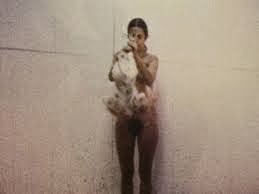

I
once read that the best way to understand the level of importance an artist has had
in art history is the extent to which his or her work can be seen in that of the
next generations of artists coming after them.
If this is the case then Ana Mendieta is a far more influential artist
than she is given credit for as traces of work can be seen in artists as
diverse as Cindy Sherman, Janine Antoni, Anthony Gormley, Jenny Saville and
Pipilotti Rist. In this first
retrospective of her work to be held in the UK is a long time coming and given
that Mendieta’s work seems contemporary even
today, it must have been extremely cutting edge when originally created in the
early 1970s. Undertaking an MA in
Intermedia as it was called at that time would have been a bold and avant garde
programme of study which is now standard practice for many art students
today. Video and photography documenting
her performances both staged in the studio and engaging in site specific
landscapes dominate this exhibition and Mendieta’s obsession with her own body from
the very outset of her practice and blood (fake or real) permeated throughout her practice whether it be slowly
seeping out of her skull in a video documented staged performance, dripping
from a decapitated chicken (again in a video) or used as paint in her early
blood drenched drawings.



For
Mendieta, blood was a magical, powerful thing both metaphorically and
materially. She is perhaps best known
for her earth-body sculptures that combined ritual with metaphors of life, death,
rebirth and spiritual transformation and has been firmly placed within art
history narratives essentialist feminists of the early 1970s such as Judy Chicago,
Carolee Schneemann, Hannah Wilke and Valie Export and she was a member of the AIR
Gallery, the first all-female cooperative art gallery formed in New York in
1972.

There are elements of essentialism in her work and there can
be no doubt that her work was very politically motivated, but Mendieta managed
to achieve that fine and almost elusive balance of being politically engaged
without being too obvious or preaching. The
work stands up for itself aesthetically as well as conceptually. This can be seen best in her Siluetas series, either when only traces
of the outline of her body in a landscape can be seen, or when her whole body is evident but becomes almost
indistinguishable from the landscape itself. Mendieta’s life story is a film script
waiting to be developed. Born in Cuba in
1948 and sent to America when she was fifteen to escape Castro’s Communist
regime, she lived and studied art in Iowa.
She then lived and worked in Mexico for many years, before settling in
New York in 1978. Mendieta died in 1985 in New York from a fall from her 34th floor apartment in Greenwich Village where she lived with
her husband of eight months, minimalist sculptor Carl Andre.
Just prior to her death, neighbours
heard the couple arguing violently but there were no eyewitnesses. Andre was tried and acquitted of her murder
due to insufficient evidence. This
retrospective is a long time coming and confirms that even today, there are
female artists of great merit who have yet to achieve the level of sustained recognition
and enquiry which they rightly deserve.









